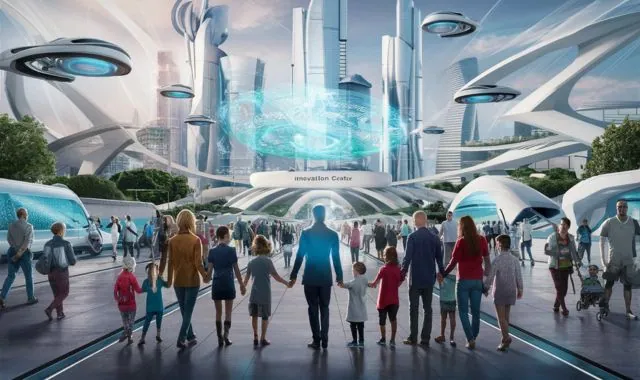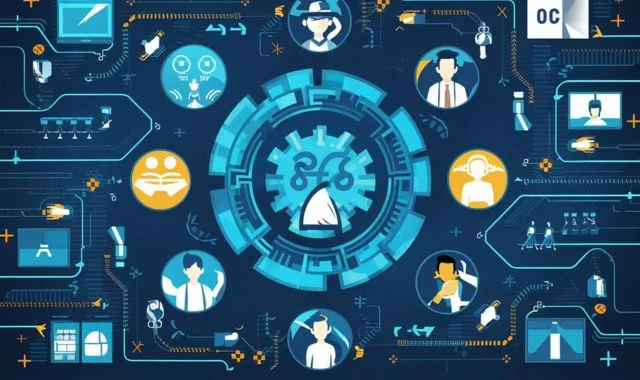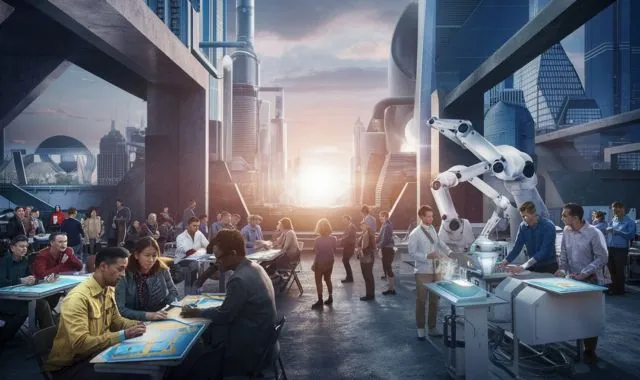Physical Address
304 North Cardinal St.
Dorchester Center, MA 02124
Physical Address
304 North Cardinal St.
Dorchester Center, MA 02124

Technological Unemployment: A Shift, Not a Shutdown ,caused by automation and AI, is a concern, but history shows new jobs emerge alongside lost ones. Optimists believe new industries will be created, while pessimists fear mass unemployment. The key is to prepare the workforce through upskilling and lifelong learning, with governments also playing a role. By embracing change, we can navigate this technological shift.

The relentless march of technology has always had a profound impact on the way we work. Today, the specter of technological unemployment looms large, raising concerns about automation and artificial intelligence (AI) rendering human labor obsolete. But is this a cause for panic, or is it simply a transition to a new kind of work?
Technological unemployment refers to the loss of jobs due to advancements in technology. This can take the form of automation, where machines take over repetitive tasks, or the development of AI, which can potentially handle complex cognitive functions previously thought to be the exclusive domain of humans.
The fear of technology replacing workers is not new. The Industrial Revolution witnessed similar anxieties, with the rise of machines threatening the livelihoods of artisans and manual laborers. However, history has shown that technological advancements often create new opportunities. The jobs lost in one sector are often replaced by new ones in another, leading to an overall increase in productivity and economic growth.
Today, automation is rapidly transforming industries. Self-service kiosks and cashierless stores are replacing cashiers in retail. Manufacturing lines are increasingly staffed by robots, displacing factory workers. Even the service sector, once considered immune to automation, is feeling the impact. AI-powered chatbots are taking over customer service roles, while algorithms are streamlining tasks in sectors like finance and healthcare.
The impact of technological unemployment is a subject of heated debate.
Optimists argue that technology creates more jobs than it destroys. New industries emerge as a result of technological breakthroughs, requiring a new set of skills. For example, the rise of the internet has spawned entirely new job categories like web developers, digital marketers, and social media specialists. Automation also allows humans to focus on higher-level tasks requiring creativity, critical thinking, and problem-solving skills – areas where humans still have a distinct advantage over machines.
Pessimists, on the other hand, worry that AI might eventually become sophisticated enough to automate even complex jobs currently thought to be safe. This could lead to mass unemployment, social unrest, and widening inequality.
The consequences of technological unemployment can be devastating for individuals. Displaced workers face economic hardship, a loss of identity tied to their profession, and emotional stress.
Society as a whole can also suffer. Rising unemployment can lead to increased poverty, social unrest, and a strain on social safety nets. Widening income inequality can further exacerbate social divisions.

While technological advancements offer exciting possibilities for the future of work, the transition can be fraught with challenges. Here, we’ll delve into the human cost of technological unemployment, exploring the difficulties faced by displaced workers and the potential societal consequences.
The human impact of technological unemployment is significant. Displaced workers face a multitude of challenges, including:
Loss of income can lead to financial hardship, impacting everything from housing and food security to healthcare access. This financial insecurity can create a domino effect, leading to stress, anxiety, and even depression.
Many people derive a sense of identity and purpose from their work. Job displacement can be deeply disorienting, leading to a loss of self-esteem and a sense of worthlessness.
The skills required for new jobs in the tech-driven economy may not match the skillsets of displaced workers. This creates a skills gap that can be difficult to bridge, leaving them struggling to find re-employment.
Older workers, especially those nearing retirement, may face additional challenges. Age discrimination can make it difficult for them to secure new jobs, even if they possess the necessary skills.
The impact of technological unemployment extends beyond individual struggles. It has the potential to exacerbate existing societal issues:
Automation is likely to benefit higher-skilled workers in tech-related fields. This could lead to a widening wealth gap between those who possess the in-demand skills and those who don’t. This economic disparity can breed resentment and social unrest.
High unemployment rates can lead to social unrest, with frustrations manifesting as protests or even violence. A rise in poverty and a decline in social safety nets can further contribute to instability.
As more workers are displaced, the burden on social safety nets like unemployment benefits will increase. This could put a strain on government resources, making it difficult to provide adequate support to those in need.
To navigate the changing landscape of work, we need to be proactive.
Equipping the workforce with the skills needed for the jobs of tomorrow is crucial. This requires investment in education and training programs that focus on in-demand skills such as data analysis, digital literacy, and critical thinking.
The ability to adapt and learn continuously will be a key asset in the future of work. Individuals need to embrace lifelong learning and be prepared to switch careers or upskill themselves as technology continues to evolve.
Educational institutions and training providers need to adapt their curriculums to equip students with the skills and knowledge required for the jobs of the future. This might involve a focus on STEM education, soft skills development, and fostering a growth mindset that encourages continuous learning.
Governments have a role to play in facilitating the transition to a new era of work. This can involve investing in reskilling programs, providing unemployment benefits, and establishing policies that encourage innovation and job creation in new sectors.

Technological change is inevitable, and it will continue to reshape the world of work. However, by embracing change, investing in education and training, and fostering a culture of lifelong learning, we can ensure that technological advancements create a future of opportunity and prosperity for all. The key is not to fear the rise of technology, but to learn to work alongside it and harness its potential to create a better future.
Here are some frequently asked questions on technological unemployment:
A: Technological unemployment is a real phenomenon, and automation can displace workers. However, history suggests that new jobs are often created alongside those lost.
A: Repetitive, manual jobs and those involving data processing are most susceptible to automation.
A: Skills in areas like data analysis, critical thinking, creativity, and problem-solving will be crucial in the future workplace.
A: Individuals can focus on lifelong learning, develop adaptability, and pursue upskilling or reskilling opportunities to stay relevant in the job market.
A: Governments can invest in education and training programs, provide support for displaced workers, and implement policies that encourage job creation in new sectors.